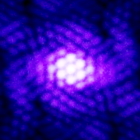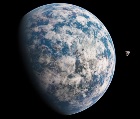|
Planets from the movie "Interstellar"
|
|
| Willocrisp | Date: Monday, 10.11.2014, 04:21 | Message # 1 |
 Space Tourist
Group: Users
 Pirate
Pirate
Messages: 29
Status: Offline
| Keep note: This may contain minor spoilers to the movie, so if you haven't seen "Interstellar" yet and want to keep everything open to view on your own; I suggest don't read this.
Is there anyway to add the planets the astronomers find in the movie "Interstellar" after entering the worm-hole?
From what I understand, it's a system of seven planets that orbit a black-hole named "Gargantua" within a distant galaxy astronauts travel to via wormhole; however, only three planets are viewed in the film.
Planet #1 - Miller's Planet

This planet is an endless shallow ocean planet closest to Gargantua with a tremendous amount of gravity. Spending one hour on the surface of this planet is the equivalent to seven years elsewhere, such as Earth. The downside to this planet are the enormous skyscraper-sized waves that occur frequently. This planet is also sterile and probably doesn't support life, because of 130% Earth gravity and the waves.
Planet #2 - Mann's Planet

This frozen wasteland is so cold, even the clouds are frozen solid. It isn't known to have a surface; however bases can be set among the ice-clouds. Days and nights are both 67 hours long and is 80% of Earth's gravity.
Planet #3 - Brand's/Edmund's Planet
This is the third planet from Gargantua and is a barren desert. It is the most habitable for life, because it's rich in oxygen and could possibly support planet growth.
This Wiki is being updated with information on the solar-system in the movie. I think it would be cool to have this added to some distant galaxy within the engine. http://interstellarfilm.wikia.com/wiki/Interstellar_Wiki
Also, I signed up through Facebook, but don't want the username willowhipcrisp. Could it be changed to Willocrisp somehow?
Edited by willowhipcrisp - Monday, 10.11.2014, 04:24 |
| |
| |
| Watsisname | Date: Monday, 10.11.2014, 17:21 | Message # 2 |
 Galaxy Architect
Group: Global Moderators
 United States
United States
Messages: 2613
Status: Offline
| Hi willocrisp! Yes, I think you can make a system like this in SE without too much difficulty. 
To begin, read the guides on how to mod a star/system and planet. The "star" in this case will be a black hole (I don't recall if they ever mention Gargantua's mass in the film, but it is clearly supermassive, so a few million solar masses would be my guess). In the next version of SE it will even be able to render the accretion disk (also with more fully accurate relativistic physics!).
As for the planets, I'd imagine Miller's as a typical Oceania, and Edmund's as a typical Mars-like desert. Mann's planet is a little less clear -- if SE can make an oceania with a completely frozen surface, that might be a good start. Perhaps give it a bunch of cloud layers as well. (Interstellar's frozen "ice sheet" clouds make no sense in real life, but hey, artistic license.)
One problem with this system would be that, unless/until light emission from accretion disks is implemented, the planets are going to be pitch black. You would have to add a star somewhere to illuminate their surfaces. I'm not sure if it'd work but maybe you could cheat this by placing a star inside of the black hole.

|
| |
| |
| Thomas988 | Date: Friday, 14.11.2014, 22:39 | Message # 3 |
 Space Pilot
Group: Users
 United States
United States
Messages: 125
Status: Offline
| I'd love to see this! This makes me want someone to make the Endurance and Rangers, as well! *hint hint, nudge nudge, for all those spaceship makers out there*
All you need in life are space games and typhlosions.
|
| |
| |
| vanguardmook | Date: Saturday, 15.11.2014, 00:01 | Message # 4 |
|
Observer
Group: Newbies
 Pirate
Pirate
Messages: 8
Status: Offline
| Quote Watsisname (  ) Mann's planet is a little less clear -- if SE can make an oceania with a completely frozen surface, that might be a good start. Perhaps give it a bunch of cloud layers as well. (Interstellar's frozen "ice sheet" clouds make no sense in real life, but hey, artistic license.)
I found a planet (an ice world) that greatly reminded me of Mann's planet:


Ice worlds are just frozen oceanias ingame.
|
| |
| |
| FastFourierTransform | Date: Saturday, 15.11.2014, 10:58 | Message # 5 |
 Pioneer
Group: Local Moderators
 Spain
Spain
Messages: 542
Status: Offline
| I haven't seen Interstellar yet but I know as all of you that is very very accurate and realistic in it's representation because they hired Kip Thorne an all that stuff.
But I have a few questions then because it seems to me extremely stupid and I want to check if for someone this makes sense.
Miller's Planet
Quote Willocrisp (  ) The downside to this planet are the enormous skyscraper-sized waves that occur frequently
Well, are such waves posible on a planet? I mean, it has a gigantic moon or something that generates powerfull waves, floods and maybe walls of water in bottle necks near the coasts like that? It would be interesting to see the maximum size allowed in the universe for waves apearing periodically. I think the atmosphere would damp these waves, and without atmosphere It would be equally nonesense because the water and every liquid would boil rapidly. All of this makes a strange paradox to me because the planet has 130% of Earth's gravity, and therefore the waves should be a lot smaller.
Mann's planet
Quote Willocrisp (  ) even the clouds are frozen solid
What does that even mean? if you freeze a cloud I don't think it would create a large solid blob of ice. It would just create a miriad of snowy particles that would fall on the ground. But the trully nonsense for me is the fact that the clouds make a solid surface. What? has the atmosphere freeze instantaneously and therefore created a sphere concentric with the real surface of the planet (that magically holds into place and dosen't colapse and deform even with those weights)? Or they are more like solid clouds floating from one place to the other (like in that Avatar absurd moon) holded by mysterius forces on air?
Is that really Interstellar? I mean, hurra for Kip thorne's depiction of a black hole lens distortion but what about the rest of the film? I don't know if I want to see it after knowing this things. Really, the universe it's so amazing but people still want to make banal commonplace sci-fi. What do they thinked? Oh okey so let's put water like in our home planet but because we want to make it appear a bit alien we can make the water waves enormous!!! genius. Then other planet, oh okey let's put clouds on that planet like those I see in my backyard but hey, we want to make it exotic and alien so let's make the clouds solid rocks (yes, they would still be floating because you know they are clouds and there's a law of physics that say the clouds must be floating). What is the next thing? oohh, I will put trees on that planet, but because those are alien trees they have to grow upside down. I don't think that this is good imagination or real sci-fi (yes I know, I'm a bit extreme with the criticism). At the end reality it's always far beyond what folklorical pop-culture tries to bring in this movies. With this kind of thinking we wouldn't have ever immagined that there are stars that ignite pwerfull polar jets and spin in periods of fractions of a second. Maybe if we tried to depict reality as accurate as posibble it would be a movie to strange to understand.
Well, beside that. I'm glad this spectacular show called Interstellar would bring some atention to astrophysics.
|
| |
| |
| SolarLiner | Date: Saturday, 15.11.2014, 14:19 | Message # 6 |
 Explorer
Group: Users
 France
France
Messages: 267
Status: Offline
| Quote FastFourierTransform (  ) Well, are such waves posible on a planet?
The planet being right next to the black hole, I guessed the waves came from its huge gravitational pull.
Quote FastFourierTransform (  ) What does that even mean?
All you see from those are a small crack as a lander touches one of them. So you guess it's frozen solid, like a huge hailstone or something.
custom landing page to share: http://bit.ly/spaceengine
|
| |
| |
| Aerospacefag | Date: Saturday, 15.11.2014, 15:31 | Message # 7 |
 Pioneer
Group: Users
 Russian Federation
Russian Federation
Messages: 401
Status: Offline
| Quote SolarLiner (  ) The planet being right next to the black hole, I guessed the waves came from its huge gravitational pull.
In fact, the real problem comes from the fact that such type of waves never emerge in the deep oceans. In the deep water, these waves are much wider and much lower, and only when they come to shallow water, they grow huge and do harm while crashing on the coast.
http://www.youtube.com/watch?v=-VcWF8dIDj4
In fact, most obvious physical problem is that such huge object - the black hole - would not simply create huge waves in the ocean, it would tear the planet apart and disperse it in the thin dust sprite in its accretion disc.
Quote FastFourierTransform (  ) What does that even mean? if you freeze a cloud I don't think it would create a large solid blob of ice. It would just create a miriad of snowy particles that would fall on the ground.
http://en.wikipedia.org/wiki/Deposition_(phase_transition)
Quote FastFourierTransform (  ) Well, beside that. I'm glad this spectacular show called Interstellar would bring some atention to astrophysics.
Let's say, if the movie is better than Avatar, it is good enough to rewatch.
Edited by Aerospacefag - Saturday, 15.11.2014, 15:46 |
| |
| |
| Watsisname | Date: Saturday, 15.11.2014, 19:11 | Message # 8 |
 Galaxy Architect
Group: Global Moderators
 United States
United States
Messages: 2613
Status: Offline
| Quote Aerospacefag (  ) Let's say, if the movie is better than Avatar, it is good enough to rewatch.
If you mean the Avatar movie by Shyamalan then that's really not saying much.  That must be one of the worst films ever made and I wouldn't even watch it once. I'd say Interstellar is absolutely worth watching once, and for me good enough to watch twice in theatre, which is an extremely rare thing these days. That must be one of the worst films ever made and I wouldn't even watch it once. I'd say Interstellar is absolutely worth watching once, and for me good enough to watch twice in theatre, which is an extremely rare thing these days.
@ FastFourierTransform,
Don't base your decision to see the film on how accurate its science is. It is a sci-fi, and not all good sci-fi must be pure hard sci-fi. It'd be a bleak genre otherwise. Base your choice instead on how good the story elements, acting, visuals, and musical score are. It is an incredible and emotional ride.
But as for the science,
The waves on Miller's planet do make sense as being caused by the very strong tidal forces from the black hole. However, they would not look like vertical waves, but rather wide, smooth bulges on the planet. There would be two of them, one facing the black hole and the other away, and the planet rotates beneath them. Although their amplitudes might be enormous, you wouldn't notice them at all, and the ship would be smoothly carried over them without ill effect. So the film is dramatizing the "waves" for sake of drama and plot.
(There's also the question of whether these same tidal forces would just shred the planet entirely [they probably would], but that's another matter).
Mann's frozen clouds:
These make absolutely no sense whatsoever, and IMO are the part of the film that takes the most artistic license. I think Kip himself said something to the same effect. But Nolan loves huge, mind-bending settings whether they are plausible or not.
There are frozen clouds on Earth (e.g. cirrus clouds), but these are simply a fog of ice crystals, not a solid mass. A cloud as solid suspended mass simply cannot exist. Even leaving formation issues aside, they would collapse under their own weight due to their high density compared to surrounding air. Even if they are interconnected layers, it's very hard to imagine how they would be strong enough to be self supporting.
There are very many things I could say about the good and the bad of the black hole physics in Interstellar, but not in this thread.

|
| |
| |
| SolarLiner | Date: Saturday, 15.11.2014, 20:50 | Message # 9 |
 Explorer
Group: Users
 France
France
Messages: 267
Status: Offline
| Quote Aerospacefag (  ) it would tear the planet apart and disperse it in the thin dust sprite in its accretion disc.
Tidal forces and Roche limit, yeah I know. But that's wayy to many physics for the average viewer.
custom landing page to share: http://bit.ly/spaceengine
|
| |
| |
| Destructor1701 | Date: Sunday, 16.11.2014, 14:14 | Message # 10 |
|
Pioneer
Group: Users
 Ireland
Ireland
Messages: 533
Status: Offline
| That raises the question though: SE takes some of those factors into account - will it allow a planet to be placed on the verge of a black hole's event horizon?

|
| |
| |
| Watsisname | Date: Sunday, 16.11.2014, 18:33 | Message # 11 |
 Galaxy Architect
Group: Global Moderators
 United States
United States
Messages: 2613
Status: Offline
| Sure, if you put one there. But it will never naturally generate a planet there.
Added: I just realized Aerospacefag meant Avatar, the sci fi movie about Pandora, not the Last Airbender. I don't know how I forgot that movie. It's like, infinitely better. 

|
| |
| |
| kham132 | Date: Monday, 22.12.2014, 02:11 | Message # 12 |
 Space Pilot
Group: Users
 United States
United States
Messages: 114
Status: Offline
| I have an idea! If you're going to put the Gargantua system into the game, make the planets orbit a star around the black hole. hope this helps!
"Fancy and inspirational quote."
- Famous Person
|
| |
| |
| Watsisname | Date: Monday, 22.12.2014, 03:48 | Message # 13 |
 Galaxy Architect
Group: Global Moderators
 United States
United States
Messages: 2613
Status: Offline
| Why? There aren't any stars in the system, and the planets orbit the hole directly, rather than around something else orbiting the hole. Space Engine can create such a system just fine. If you mean adding a star for supplying illumination in leu of the accretion disk, then I'd say try putting it inside the black hole and see if that works favorably.
Then again, the backstory is that there is supposed to be a neutron "star" in the Gargantua system, orbiting fairly close to the hole. It was meant to allow the Endurance to change orbits at a much lower delta-v cost (changing orbits around a supermassive black hole is stupidly expensive in reality), by using it to perform gravitational slingshots. The neutron star isn't shown explicitly, though Cooper delivers a very quick line about it when they're deciding whether to visit Miller's planet.

|
| |
| |
| anonymousgamer | Date: Monday, 22.12.2014, 04:45 | Message # 14 |
 World Builder
Group: Global Moderators
 United States
United States
Messages: 1011
Status: Offline
| Quote Watsisname (  ) then I'd say try putting it inside the black hole and see if that works favorably.
Doc tried that and it didn't work
Desktop: FX-8350 4.0 GHz, 8 GB DDR3 RAM, EVGA GeForce GTX 1080 FTW 8 GB, 2 TB HDD, 24 inch 1920x1080 screen
Laptop: Core i5 480M 2.66 GHz (turbo 2.93), 8 GB DDR3 RAM, AMD Radeon HD 6550m 1 GB, 640 GB HDD, 17.3 inch 1600x900 screen
|
| |
| |
| Watsisname | Date: Monday, 22.12.2014, 05:36 | Message # 15 |
 Galaxy Architect
Group: Global Moderators
 United States
United States
Messages: 2613
Status: Offline
| Bummer. Hmm, I wonder how much light would the neutron star would provide? Probably not enough to make the planets habitable.

|
| |
| |